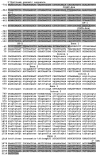Studies on Acanthocheilonema viteae cystatin: genomic organization, promoter studies and expression in Caenorhabditis elegans
- PMID: 16091144
- PMCID: PMC1187909
- DOI: 10.1186/1475-2883-4-9
Studies on Acanthocheilonema viteae cystatin: genomic organization, promoter studies and expression in Caenorhabditis elegans
Abstract
Cystatins are reversible, tightly binding inhibitors of cysteine proteases. Filarial cystatins have been ascribed immunomodulatory properties and have been implicated in protective immunity. To continue exploration of this potential, here we have determined the sequence, structure and genomic organization of the cystatin gene locus of A. viteae. The gene is composed of 4 exons separated by 3 introns and spans approximately 2 kb of genomic DNA. The upstream genomic sequence contains transcriptional factor binding sites such as AP-1 and NF-Y, an inverted CCAAT sequence, and a TATA box. To investigate sites of cystatin expression, Caenorhabditis elegans worms were transformed by microinjection with the putative promoter region and the first exon of the A. viteae cystatin gene fused to the reporter GFP. In transgenic worms fluorescence was observed in the pharyngeal and rectal gland cells suggesting that cystatin is secreted. Additionally, A. viteae cystatin was expressed in C. elegans to explore its potential as an expression system for filarial genes.
Figures




Similar articles
-
Genomic organization of an avermectin receptor subunit from Haemonchus contortus and expression of its putative promoter region in Caenorhabditis elegans.Mol Biochem Parasitol. 2004 Apr;134(2):267-74. doi: 10.1016/j.molbiopara.2004.01.002. Mol Biochem Parasitol. 2004. PMID: 15003846
-
Parasite-specific immunomodulatory functions of filarial cystatin.Infect Immun. 2003 May;71(5):2422-9. doi: 10.1128/IAI.71.5.2422-2429.2003. Infect Immun. 2003. PMID: 12704112 Free PMC article.
-
Structural organization of the gene encoding rat cystatin beta.Gene. 1992 May 15;114(2):257-60. doi: 10.1016/0378-1119(92)90584-c. Gene. 1992. PMID: 1601307
-
[Cres (cystatin-related epididymal spermatogenic) gene regulation and function].Zhonghua Nan Ke Xue. 2002;8(5):313-8. Zhonghua Nan Ke Xue. 2002. PMID: 12479114 Review. Chinese.
-
Cystatins from filarial parasites: evolution, adaptation and function in the host-parasite relationship.Int J Biochem Cell Biol. 2008;40(6-7):1389-98. doi: 10.1016/j.biocel.2007.11.012. Epub 2007 Dec 4. Int J Biochem Cell Biol. 2008. PMID: 18249028 Review.
References
-
- Hartmann S, Kyewski B, Sonnenburg B, Lucius R. A filarial cysteine protease inhibitor down-regulates T cell proliferation and enhances interleukin-10 production. Eur J Immunol. 1997;27:2253–2260. - PubMed
LinkOut - more resources
Full Text Sources

